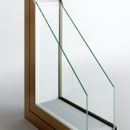Please help me understand this R40+ window design
If you read down the article, they’ve got a “diagonal” model that is supposed to achieve
R113 something … WTF????
Why aren’t we all using this as walls ?
I don’t understand what are the principles behind this sorcery,
how could something this shallow achieve such a R value ?
Would like to discuss your ideas about this design ?
any help finding the patents would be good also 🙂
IF they can achieve anything over R50 in a window, how come aren’t we all working
toward developping this idea for using all over walls ???
I would quickly think that they are using convection for some purpose in the diagonal type window,
i don’t see what other benefits diagonal lines as such would have .
GBA Detail Library
A collection of one thousand construction details organized by climate and house part











Replies
Thanks for the info, awesome!... If it holds true and price gets to be somewhat competitive, we'll see more window companies going there. Ahhh... more glass buildings!
If the R100 something whatever holds true, we will need to work on using this method for walls
and all other things taht require high insulation ...
even at R40 for 6.5" ..incredible
it doesn't need to be R100 when you take into account the balance. the presentation they did at the passivhaus conference was pretty incredible. they were still in the development phase and looking for a VC, but in terms of game changing ideas - an all glass building in moscow?
pretty dang cool.
Please Mike enlighten us with your knowledge!!
What do you mean "account the balance" ??
You assisted a presentation ? Please tell me more :)
jin,
no, i attended their presentation (superwindows.eu) at the passivhaus conference in hannover.
basically, when you take into account the balance of gains/losses - i don't believe the R113 glass wouldn't needed (especially in commercial buildings). but it's an innovative and interesting concept.
the presenters showed two window concepts, one with ultrathin glass situated diagonally to two panes of glass, and another with several layers of ultrathin glass set parallel to the two exterior panes. the windows would be less weight than traditional tri/quad pane windows due to the incorporation of the 50 μm ultra thin (and flexible) glass .
much of the discussion at the conference centered around specifics, however the window's only a prototype. the diagonal version was seen as a method for reducing convective loops and increasing performance by compartmentalizing temperature distribution (if i remember correctly). there were a bunch of questions regarding thermal bridging of the two exterior panes (by the thin glass), cost, structural and visibility issues at point diagonal sheets intersect w/ exterior panes - but again, it was only a concept (albeit a mindblowing one). the other concept (the 10+ ultra thin panes in series) seems much more intriguing/viable and had no visibility degradation (as opposed to quad films, which do)
Jin, I found this page when I "googled"
http://superwindows.eu/en/superwindows/invis160-tweed/idee/
it gets into more detail and patent info
ok super ..i don't know why but i missed it on their website ..
the thermal convection design is exactly what i thought when i first saw the diagonal pane design ..
but still .. how can they get up to r100+ with only 160mm ??
what's the best insulating gas ??
There is something i do not understand
from the link you provided ..they say :
""" achieve a Ug even lower than 0.05 W/m2K """"
but on this page : http://superwindows.eu/en/superwindows/invis160-tweed/prototypy/
if you look at the test results .. we see nothing close to this ..
am i mixing up the numbers ?
thye get 0.5 w/m2k of """ thermal transmittance with standardized heat flow density """
anyhow ..reading their patent now :)
wow i am not sure i get anything from the patent ..not what i expected
let me know if you guys understand some of the basic principles in this very repetitive text :p
Anyone would care to join in with some input on understanding the principles behind this design ??
I thought they were playing with convection and delta T optomisation ,
but this picture on their site makes it hard to understand for me :(
Jin,
What's your question? The diagonal placement of the plastic films interrupts the convective loops and improves the thermal performance of the window.
Martin : please explain the convection loops system ?
What i see on this particular pictures is some diagonal strips that goes from outside to inside ???
Is it because it is affected also by the one on top and on bottom of it ?
then, why is it that they announce for higher thermal resistivity than the pure gaz fill they use ??
Jin,
The plastic films divide the space into compartments -- just as triple glazing creates two compartments.
If the plastic films are vertical, convective loops occur in each compartment. The convective loops cause more heat flow.
If the plastic films are diagonal, there is a reduced opportunity for convective looping. The compartments still exist; the fact that there are so many compartments reduces heat flow, which is good. The gas in each compartment is less likely to move around, which is also good.
http://gfp.lbl.gov/performance/default.htm
Is this accurate ?
Krypton is around R12 ??